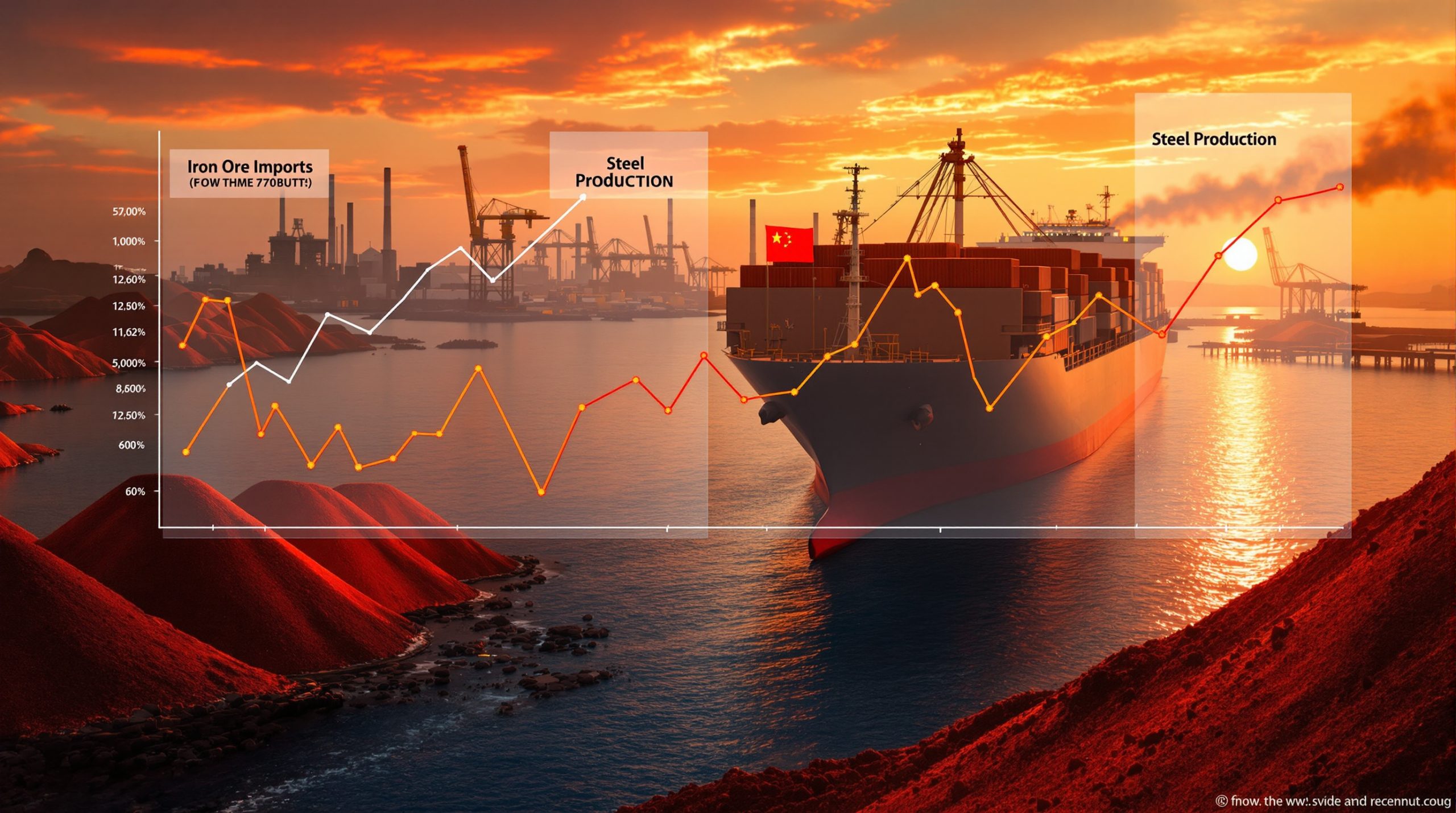What Factors Are Currently Influencing Aluminum Prices?
Macroeconomic Factors and Market Sentiment
The aluminum market currently faces significant pressure from both global and domestic economic forces. According to the latest Shanghai Metal Market (SMM) analysis, trade disruptions resulting from overseas tariffs impacting markets continue to create uncertainty in metal markets, affecting both pricing and supply chain stability.
U.S. inflation data is playing a crucial role in market sentiment, with expectations that recent tariffs may push core inflation to approximately 2.9% in upcoming reports. This potential inflation acceleration in goods like furniture and toys could trigger monetary policy responses that would impact industrial metal demand.
Meanwhile, the domestic economic environment in China maintains a generally favorable atmosphere for industrial sectors, with policies supporting manufacturing and infrastructure development remaining in place despite global headwinds.
Interest rate differentials between major economies are creating commodity market volatility, which in turn affects aluminum pricing in various regions and complicates international trade calculations for market participants.
Supply-Side Dynamics
Recent operational capacity adjustments in primary aluminum production have created noticeable market impacts. According to SMM's July 2025 report, domestic operating capacity of electrolytic aluminum has slightly decreased due to several ongoing replacement projects.
A particularly significant shift is occurring in production formats, with the proportion of liquid aluminum dropping to 74.78% while casting ingot production increases. This transition signals that more metal is being cast into ingots for storage rather than flowing directly to fabricators—a clear indication of weakening downstream demand.
Cost pressures continue mounting from the raw material side, with rising alumina prices pushing production costs upward across the industry. This upward cost trend creates a price floor for primary aluminum, preventing deeper price declines despite lackluster demand.
Regional production differences are becoming more pronounced, with some areas maintaining higher output while others face greater operational challenges. These geographic disparities contribute to widening price spreads between regions, with the Henan-Shanghai differential recently expanding to 140 yuan/mt.
How Is Inventory Buildup Affecting Aluminum Market Conditions?
Current Inventory Trends
A notable reversal from drawdown to accumulation has occurred in social inventories of domestic electrolytic aluminum ingots, according to SMM's latest warehouse monitoring. This inventory buildup during what should be a period of strong seasonal demand signals underlying weakness in consumption patterns.
Weekly warehouse outflow statistics reveal a concerning trend: ingot outflows registered at 100,100 metric tons, representing a decrease of 7,500 metric tons week-over-week. Interestingly, billet outflows increased to 44,200 metric tons, up 9,400 metric tons from the previous week, suggesting some divergence in product-specific demand.
Regional inventory disparities have become increasingly pronounced across major consumption hubs. While specific regional breakdowns weren't detailed in the SMM report, market participants note that eastern coastal areas are showing different inventory accumulation patterns compared to central and western regions.
Inventory-to-consumption ratios are gradually rising above historical norms for this period, creating additional downward pressure on prices as buyers anticipate further accumulation and potential price declines.
Market Insight:
"The current inventory accumulation during what should be a period of seasonal drawdown represents a significant deviation from normal market patterns and suggests deeper issues with downstream demand than initially anticipated." — SMM Aluminum Market Analysis, July 2025
Price-Inventory Relationship Analysis
Historical correlation between inventory levels and price movements suggests the current buildup will continue to pressure aluminum prices and inventory buildup in the near term. SMM analysts note that price elasticity during inventory accumulation periods tends to be more pronounced than during drawdowns, creating asymmetric market responses.
While specific threshold inventory levels that typically trigger market responses weren't detailed in the latest report, the ongoing accumulation appears to be approaching levels that historically precede more significant price adjustments.
Seasonal patterns in inventory accumulation normally show declines during this period rather than increases, making the current buildup particularly bearish for market sentiment. This unseasonal accumulation reinforces concerns about fundamental demand weakness.
Inventory financing dynamics are further complicated by the current interest rate environment, which affects the carrying costs of metal stocks. Higher interest rates increase the cost of holding inventory, potentially accelerating liquidation if market participants lose confidence in near-term price recovery.
What Role Does Seasonal Demand Play in Current Aluminum Pricing?
Off-Season Demand Patterns
Traditional consumption cycles in key aluminum-consuming sectors show the market currently experiencing what SMM describes as a "strong off-season atmosphere." This seasonal weakness is being exacerbated by price increases earlier in the cycle, which further suppressed purchasing activity.
Current operating rates across downstream fabrication industries remain "sluggish" according to SMM's latest assessment. While specific utilization percentages weren't provided, the qualitative description points to significantly below-average activity levels for this time of year.
Order book trends among major aluminum processors show limited forward commitments, with many fabricators operating on minimal inventory and just-in-time purchasing patterns. This hesitancy to secure forward material reflects uncertainty about end-market demand and price direction.
Regional variations in seasonal demand patterns are evident, with coastal export-oriented fabricators facing different dynamics than inland producers serving domestic markets. These geographic differences contribute to the widening price spreads between regions like Henan and Shanghai.
Comparison of current off-season metrics to historical averages suggests this year's seasonal slowdown is more pronounced than typical patterns, potentially indicating broader economic concerns beyond normal cyclicality.
Downstream Sector Performance
Construction industry demand indicators have weakened considerably, with building activity in key markets showing less aluminum consumption than forecast earlier in the year. This sector traditionally accounts for a significant portion of aluminum demand, making its current weakness particularly impactful.
Automotive sector consumption patterns remain under pressure as production rates face challenges from both supply chain issues and shifting consumer demand patterns. While electric vehicle production continues to grow, it hasn't fully offset weakness in conventional vehicle manufacturing.
Packaging industry utilization rates have shown greater resilience than other sectors, but even this traditionally stable segment has reduced ordering patterns compared to previous years. The diversification of packaging materials has also created additional competitive pressure for aluminum.
Consumer durables manufacturing activity levels remain below expectations, with household appliance and electronics production failing to generate anticipated aluminum demand. This weakness in consumer-oriented products suggests broader economic concerns affecting household purchasing power.
Infrastructure project pipeline impacts on future demand appear mixed, with some regions accelerating development while others face delays or cancellations. The uneven nature of these projects creates additional uncertainty for forecasting near-term aluminum consumption.
How Are Secondary Aluminum Markets Responding to Current Conditions?
Scrap Market Dynamics
Price differentials between primary and secondary materials have narrowed in recent weeks, reflecting the complex interplay between scrap availability and primary aluminum price movements. According to SMM's latest data, baled UBC (used beverage can) aluminium scrap assessments fell to 15,150-15,650 yuan/mt (ex-tax), representing a decrease of 250 yuan/mt week-over-week.
Regional variations in scrap collection and processing have become more pronounced, with some areas experiencing greater supply constraints than others. This geographic disparity contributes to the wide price ranges reported for various scrap categories.
Supply constraints in high-quality recyclable materials remain significant, particularly for certain grades. SMM reports that shredded aluminum tense scrap maintains relatively stable pricing at 15,800-17,300 yuan/mt (ex-tax) due to persistent supply tightness, showing greater resilience than other scrap categories.
Pricing trends across different scrap categories show divergence based on quality and processability. While UBC prices closely track primary aluminum movements, higher-grade industrial scrap maintains stronger pricing power due to its consistent quality and lower processing requirements.
Environmental policy impacts on scrap availability and processing continue to evolve, with regulatory changes affecting collection systems, processing requirements, and cross-border movements of recyclable materials. These regulatory factors create additional complexity in scrap supply chains.
Alloy Market Conditions
ADC12 and other key alloy prices have shown relative stability compared to primary aluminum, with SMM reporting ADC12 prices decreasing by only 100 yuan/mt to 20,000 yuan/mt despite primary aluminum's larger 320 yuan/mt decline. This relative resilience reflects the different supply-demand dynamics in the secondary market.
Production adjustments among secondary smelters have become increasingly common, with SMM noting that several producers have implemented production cuts or even temporary shutdowns due to raw material shortages and weakening demand. These operational changes help stabilize secondary market pricing by reducing available supply.
The cost-price squeeze affecting secondary producers has intensified, with input costs remaining elevated while product prices face downward pressure. This margin compression is a primary driver behind production curtailments in the secondary sector.
End-user purchasing behavior for secondary products remains cautious, with buyers limiting order volumes and seeking price concessions. However, the reduced availability of secondary materials due to production cuts creates a counterbalancing force against excessive price declines.
Quality premiums and discounts in the current market have shifted, with higher-quality secondary alloys maintaining stronger pricing power relative to standard grades. This quality-based differentiation reflects end-users' focus on material performance and consistency even in a challenging market environment.
What Are the Trade Flow Implications for Aluminum Markets?
Export and Import Trends
Recent export statistics for unwrought aluminum and semis show significant declines, with SMM reporting June exports at 489,000 metric tons, representing a substantial 19.84% decrease year-over-year and a 10.60% drop month-over-month. This export weakness reflects both domestic and international market challenges.
Year-over-year and month-over-month trade volume changes paint a concerning picture for market participants. January-June cumulative exports totaled 2.919 million metric tons, showing an 8.00% decrease compared to the same period last year, indicating persistent trade headwinds.
The impact of US-China trade war impact on international aluminum flows remains significant, with SMM specifically citing "disruptions to trade flows caused by overseas tariffs" as a continuing market factor. These policy measures create artificial barriers that distort natural supply-demand balancing mechanisms.
Regional arbitrage opportunities influencing trade patterns have shifted as price relationships between major markets evolve. The changing dynamics between domestic Chinese prices and international benchmarks affect the competitiveness of exports and the attractiveness of imports.
Value-added product export trends versus primary metal shipments show divergence, with some fabricated products maintaining stronger export performance than unwrought materials. This differentiation reflects varying levels of demand resilience across product categories.
International Price Arbitrage
LME-SHFE price differential analysis shows continuing disconnects between international and Chinese domestic markets. SMM reports LME aluminum opening at $2,603 and closing at $2,596.5 during the latest session, while SHFE futures showed different patterns, influencing cross-border trade calculations.
Physical premium trends across major consumption regions have adjusted to reflect regional supply-demand balances. These premiums, charged above exchange prices for physical delivery, serve as sensitive indicators of local market conditions.
Freight and logistics cost impacts on arbitrage opportunities remain significant, with transportation expenses affecting the economics of moving metal between markets. These costs create effective thresholds that must be exceeded before arbitrage becomes economically viable.
Currency fluctuation effects on international trade competitiveness continue to create additional complexity for market participants. Exchange rate movements between the yuan, dollar, and other major currencies directly impact the relative attractiveness of Chinese exports and imports.
Import/export policy changes affecting cross-border movements create uncertainty for traders and consumers alike. Evolving regulations, including both explicit trade measures and environmental or quality standards, influence what materials can move between markets and at what cost.
What Technical Indicators Are Shaping Aluminum Price Movements?
Futures Market Analysis
Contract volume and open interest trends on the SHFE show evolving market positioning. According to SMM's latest report, the SHFE aluminum 2508 contract opened at 20,390 yuan/mt and closed at 20,405 yuan/mt during the night session, reflecting modest price stability despite underlying concerns.
Technical support and resistance levels have adjusted following recent price movements. The primary aluminum spot price decline of 320 yuan/mt to 20,470 yuan/mt has established new technical reference points that traders are closely monitoring for future direction.
Trading patterns across different contract months reveal market expectations about future price trends. The term structure of the futures curve provides insights into anticipated supply-demand balances over coming months.
Market positioning among commercial and non-commercial traders has shifted in response to changing fundamentals. Industrial hedgers and financial speculators are adjusting their exposures based on divergent views about near-term price direction.
The backwardation/contango structure and its implications for market dynamics continue to evolve. This relationship between near-term and future contract prices influences inventory financing decisions and physical market behaviors.
Price Spread Dynamics
Regional price differentials and their evolution show increasing market fragmentation. SMM reports that the price spread between Henan and Shanghai markets has widened to 140 yuan/mt, expanding by 10 yuan/mt from the previous day, reflecting regional variations in supply-demand balances.
Cash-to-three-month spread movements provide insights into near-term market expectations. This time spread indicates the market's assessment of immediate supply tightness relative to conditions expected in the coming months.
Physical premium trends across delivery locations have adjusted to reflect local conditions. SMM notes spot discounts of approximately 60 yuan/mt against the SHFE July contract, indicating specific pressures in the physical market.
Product category price differentials between ingot and billet have shifted, with billet outflows increasing while ingot movements decline. This product-specific divergence reflects varying demand patterns across different aluminum formats.
Quality-based premium variations continue to reflect processor preferences for specific material characteristics. These quality differentials remain important even during market downturns, as fabricators prioritize consistency and performance.
What Are the Short-Term and Medium-Term Price Outlook Scenarios?
Near-Term Price Projections
Key price support and resistance levels to monitor have adjusted following recent market movements. The significant 320 yuan/mt decline in spot prices has established new technical reference points that will influence trading behavior in coming sessions.
Potential trigger events that could shift market direction include the upcoming release of U.S. CPI data, which may influence broader commodity sentiment through its impact on interest rate expectations and dollar strength. SMM specifically highlights this data release as a key market-moving event.
Supply-demand balance expectations for coming months suggest continued downward pressure on prices. SMM analysts explicitly state that "aluminum prices and inventory buildup are expected to be under pressure in the short term due to inventory buildup and off-season demand."
Seasonal factors likely to influence price direction remain important, with the current "strong off-season atmosphere" expected to persist before transitional improvement later in the quarter. This seasonal pattern is being closely monitored for any deviations that might signal changing underlying fundamentals.
Cost-floor analysis based on production economics suggests limited downside from current levels. Rising alumina prices are creating upward cost pressure that establishes effective price floors below which primary production becomes economically challenging.
Medium-Term Market Considerations
Capacity expansion projects in the pipeline will influence future supply availability. While SMM's report doesn't detail specific projects, the mention of "replacement projects" affecting current operating capacity indicates ongoing evolution of the production base.
Energy cost trajectory impacts on production economics remain critical for medium-term pricing. Aluminum's energy-intensive production process makes it particularly sensitive to power cost movements, creating an important variable for future price projections.
Downstream sector growth forecasts and implications suggest cautious optimism beyond the current seasonal weakness. The fundamental drivers of aluminum demand, including construction, transportation, and packaging, maintain positive long-term trajectories despite cyclical challenges.
Potential policy changes affecting aluminum markets could create significant impacts on both supply and demand. Environmental regulations, energy policies, and trade measures all have the potential to substantially alter market conditions over the medium term.
Technological developments influencing supply or demand continue to evolve, with innovations in both production methods and aluminum applications creating gradual but meaningful shifts in mining industry trends.
FAQ: Understanding Aluminum Market Fundamentals
What is causing the current inventory buildup in aluminum markets?
The inventory accumulation is primarily driven by weakened downstream demand during the traditional off-season period, combined with relatively stable production levels. According to SMM's analysis, the proportion of liquid aluminum has decreased to approximately 74.78%, with more metal being cast into ingots for storage rather than flowing directly to fabricators, indicating processors are operating at reduced rates.
This buildup represents a deviation from normal seasonal patterns, where even during slower periods, inventory typically maintains a more balanced relationship with consumption. The current accumulation reflects both cyclical factors (seasonal slowdown) and potentially deeper concerns about economic conditions affecting key consuming industries.
How do aluminum scrap prices typically respond to primary aluminum price movements?
Aluminum scrap prices generally follow primary aluminum price trends but with varying lag times and magnitudes depending on scrap category and regional factors. SMM's latest data shows baled UBC aluminum scrap prices have decreased by approximately 250 yuan/mt week-over-week, closely tracking primary aluminum price movements.
In contrast, shredded aluminum tense scrap shows greater price resilience due to supply constraints, maintaining levels between 15,800-17,300 yuan/mt despite primary price declines. This differential response demonstrates how supply-side factors can significantly modify the normal price relationship between primary and secondary materials.
The price transmission mechanism from primary to secondary markets typically operates with greater efficiency for standardized, high-volume scrap categories like UBC, while
Looking for the Next Major Mineral Discovery?
Stay ahead of the market with Discovery Alert's proprietary Discovery IQ model, which instantly alerts investors to significant ASX mineral discoveries and turns complex data into actionable insights. Understand why historic discoveries can generate substantial returns by visiting Discovery Alert's dedicated discoveries page and begin your 30-day free trial today.




